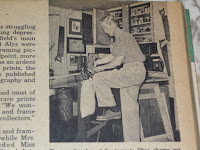Un hobby que les traería reconocimiento y dinero a
una pareja, Clint
y Alys Litchfield, durante la Gran Depresión. Un artículo
de Mechanix Illustrated de la década
de los ´50s
An anemic used-car business
struggling to stay ahead of the waning depression in 1937 was Clint
Litchfield´s main source of income when he and Alys were married. Clint´s side
line of framing pictures was, from the profit standpoint, more of a hobby. As
for Alys she was an ardent collector of old original color prints, the
hand-colored kind, and books published in the days before modern lithography
and linotype machines.
The used-car business occupied most
of Clint’s time but the stack of rare prints became the basis for an idea “We
wondered why we couldn´t mount and frame this antique art and sell it to
collectors,” Alys said.
Actually Clint’s woodworking and
framing were of first-class quality while Mrs. Litchfield´s background included
Miss Wier´s School of Design and Liberal Arts in Newark, N. J.
When they decided to try to sell their
art they soon learned that there weren´t enough collectors in the immediate
vicinity to carry such a business. Some research disclosed that as good as
their own frames and finishes were, there were dozens of woods, grains and
various styles and finishes which could be easily adapted to their ancient
pages.
 |
| Clint at his workshop |
Further study along these lines
introduced them to old-time printing processes like wood blocks, wood
engraving, etchings, etc. Moreover, if they hoped to make a paying business out
of their idea, they had to know the different kinds of paper and the markings,
lines and watermarks found in them. For instance they discovered that the
vertical lines which appeared on many old papers were not an intentional design
of the manufacturer of that paper. Digging deep into the paper-making lore,
they learned that these vertical lines were caused by the overlapping of the
sheets as they were laid out to dry after having been rolled from the pulp.
The more old prints they mounted and
framed, the more they studied and the more they studied, the less time Clint
spent at his used-car lot. The bills began piling up but after about a year
word began getting around northern New Jersey that the Litchfields were
offering rare specimens of old book art in attractive, modern frames suitable
for any home. People began to visit the modest dwelling that lacked even a
sign. Litchfield´s Fancy Prints without advertising other than word-of-mouth
was becoming a veritable gold mine of 100 to 200-year-old… (They framed a fortune, by Joseph Wherry,
from Mechanix Illustrated, July 1954)
 |
| Alys at work |
Si
querés recibir el artículo completo mandános tu inquietud
Para saber
La gran depresión
fue una severa crisis económica que tuvo lugar alrededor del mundo en la década
del ’30. En la mayoría de los países comenzó en 1929. La depresión se originó en EEUU después de una gran caída de los
precios de las acciones. En algunos países las economías se comenzaron a
recuperar a mediados de la década del ’30. El desempleo subió al 25 por ciento.
La construcción virtualmente se paró. Las comunidades rurales sufrieron al caer
los precios de los productos agrícolas. Las áreas dependientes de los sectores
primarios, como la minería y la explotación forestal, fueron las más golpeadas.
Artículos
relacionados
Radio´s
Second Childhood, un artículo de Mechanix Illustrated, y también "Rudy" Vallée, estrella
del pop de los 40
Los
Hermanos Lederer, éxitos de fracasos, y Hopalong Cassidy y el famoso Capitán Video
Y de aquellas épocas de gloria de Hollywood: Michael
Romanoff, a Hollywood restaurateur
No hay comentarios:
Publicar un comentario
Deja aquí tus mensajes, comentarios o críticas. Serán bienvenidos